Dairy Farming
Introduction
Kenya has over one million small-scale dairy farmers keeping over 70% of the 3.5 million dairy cattle that produce 4.2 billion litres of milk every year. Dairy enterprise is estimated to earn famers over one hundred billion shillings annually. It provides employment to over 350,000 people at farm level. Employs 400,000 people in informal sector and close to 50,000 people in the formal sector. The cow has been used as a bank where cows and heifers may be sold at a short notice to provide cash for school fees, hospital and investment. Manure from cattle is important by product for improving soil fertility to boost crop, forage and pasture production.
Breeding
- Select animals for breeding that have different desired traits of good quality.
- Consult veterinary & animal production experts for technical help.
Sahiwal
- Sahiwal is a dual-purpose breed.
- Heat-tolerant and well adapted to dry areas.
- Produces about 5-15 litres of milk in a day.
- Bull calves mature early and sold.
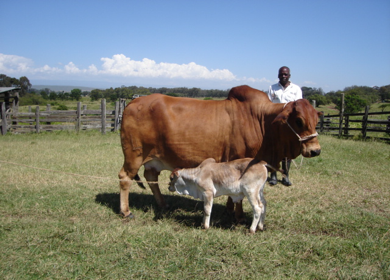
Sahiwal Friesian Cross
- Good for dry areas like Machakos, Baringo, Kajiado and Kilifi.
- Heifers mature in 24 – 26 months.
- Production averages 5-15 litres of milk daily.
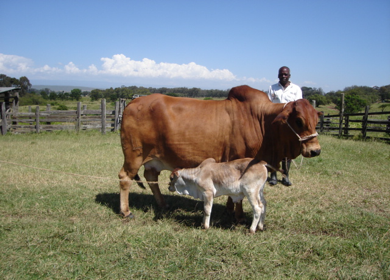
Holstein Friesian
- Black and white short haired coat, short horns or none.
- Heifers mature in 24 – 26 months.
- Milk production is 40-60 litres of milk per day depending on level of feeding and other management issues.
- Heavy feeder 90-110Kg fresh forage/day.
- Susceptible to milk fever disease and high temperatures.
- Requires large water volume, minimum 60 litres per day.
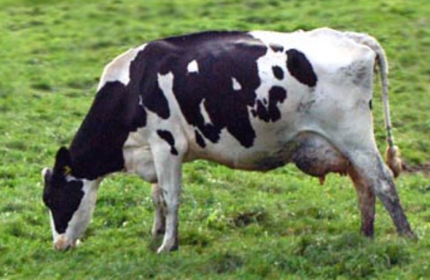
Ayrshire
- Body weight is 450kgs.
- High milk production potential 30 litres per day.
- Heifers mature in 24 – 26 months.
- Fairly hardy and adaptable to varied climatic zones in Kenya.
- They are relatively resistant to diseases.
- Feed requirements high 90-110 kg fresh forage per day.
- Require plenty of clean water 60 litres per day.
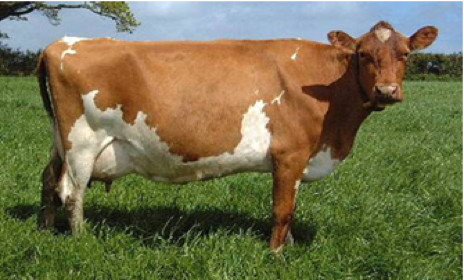
Guernsey
- High milk production potential 25 litres per day.
- Heifers mature in 18 – 22 months.
- Milk production depends on level of feeding and other management issues.
- Fairly hardy and adaptable to varied climatic zones in Kenya.
- They are relatively resistant to diseases
- Moderate feed requirement 65 – 85 kgs per day.
- Consumes 20-30 percent less for a kg of milk less than the larger breeds.
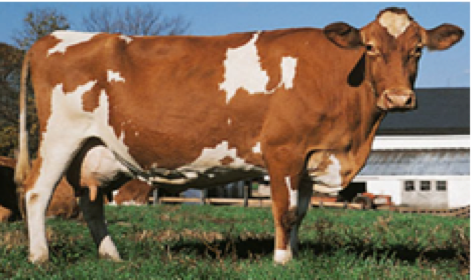
Jersey
- It’s able to adapt to different climatic conditions in Kenya.
- 20 litres milk per day with 5.0% BF (batter fat content).
- Relatively small in size weighs 350 – 400 kgs.
- Heifers mature in 12 – 16 months.
- They are relatively resistant to diseases.
- Feed requirements high 90 - 110 kg fresh forage per day.
- Require plenty of clean water 60 litres per day.
- Jerseys in Kenya are typically light brown in colour, though this can range from being almost grey to dull black.
- They can also have white patches, which may cover much of the animal. A true Jersey will however always have a black nose bordered by an almost white muzzle.
- They have protruding eyes.
- This breed is well known for milk with high quality.
- It is particularly richer in protein, minerals and trace elements than those from the larger dairy breeds.
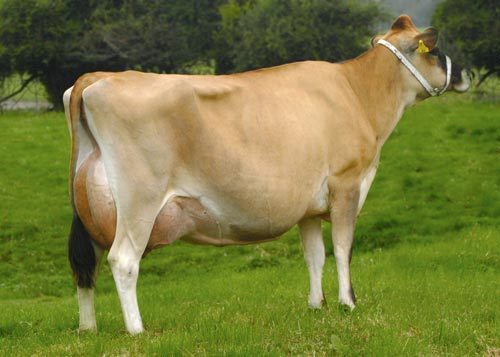
- In small scale farms it is necessary to house animals and farmers can adopt structures depending on: - land size and number of animals.
- When dairy cattle are kept within, the area should be free of mud and manure in order to reduce hoof infection.
- Concrete floors with good hoof grip are ideal to avoid falling accidents.
- However, where ample space is available, an earth yard, properly sloped for good drainage is adequate.
Zero Grazing
- Majority of dairy animals are kept by smallholder farmers in Kenya under zero grazing or semi- zero grazing systems.
- Below is a layout of a zero grazing unit for five cows.
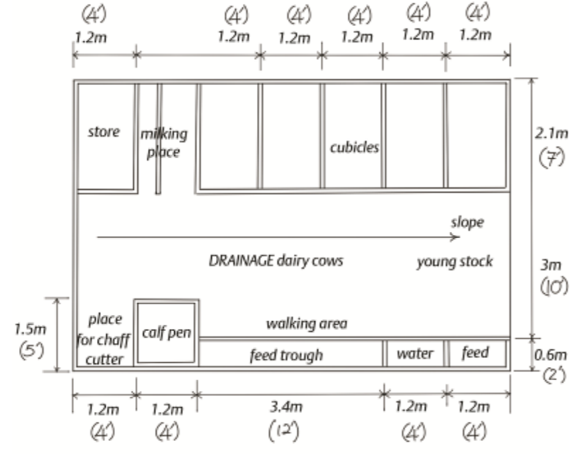
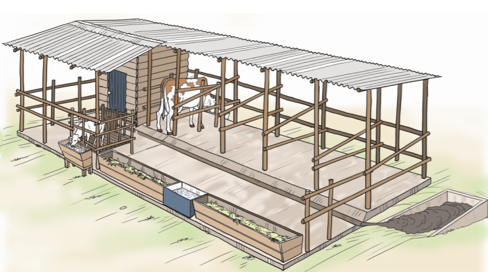
Sun Shade
- When constructing a shade structure, it should allow 2.5 to 3m per animal which will give the minimum good protection for cattle, whether it be for one animal belonging to a small holder or many animals in a commercial herd.
- The roof should be a minimum of 3m high to allow air movement.
- If financially able, all the area that will be shaded sometime during the day should be paved with good quality concrete.
- The gable roof is more wind resistant than a single pitch roof and allows for a centre vent.
- A woven mat of local materials can be installed between the rafters and the corrugated iron roof to reduce radiation from the steel and lower temperatures just under the roof by 10°C or more.
Deep-Bedded Sheds
- In a deep-bedded system, straw, sawdust, shavings or other bedding material is periodically placed in the resting area so that a mixture of bedding and manure builds up in a thick layer.
- Although this increases the bulk of manure, it may be easier to handle than wet manure alone.
- This system is most practical when bedding is plentiful and cheap.
- By designing the building to be partially enclosed on the east and west, the shading characteristics can be improved.
- A well-drained earth floor is quite adequate, such a building will compare favourable in cost with a shaded area which is paved.
Loose Housing with Free Stalls
- A loose housing yard and shed with free stalls will satisfy this need.
- Less bedding will be required and less manure will have to be removed.
- Free stalls must be of the right size in order to keep the animals clean and to reduce injuries.
- When stalls are too small, injuries to skin and teats will increase and the cows may also tend to lie in other areas that are less clean than the stalls.
- If the stalls are too large, cows will get dirty from manure dropped in the stall and more labour will be required in cleaning the shed area.
Bull Pens
- A bull pen should have a shaded resting area of 12 to 15m² and a large exercise area of 20 to 30m².
- The walls of the pen must be strong. Eight horizontal rails of minimum 100mm round timber or 50mm galvanized steel tubes to a total height of 1.5m and fixed to 200mm timber posts not more than 2m apart will be sufficient.
- The gate must be designed so that the bull cannot lift it off its hinges and there should be at least two exits where the herdsman can escape.
- A service stall where the cow can be tied up prior to and during service is usually provided close to the bull pen.
Alleyways
- It is desirable to pave the alley, but if that is not possible, the distance between the free stalls (cubicles) and the feed trough should be doubled or tripled.
- A concrete pit or sloping slab in which to accumulate manure is essential.
- If the alley is paved, the pit can also collect urine.
- The circular manure tanks a volume of 10m³ will be adequate to store the manure produced during one month plus any rainfall collected in the alley.
- If more stalls are added the capacity of the tank will need to be increased or the interval between the emptying shortened.
Water Catchment
A water tank to collect water from the roof can be very useful unless there is an abundant supply of water nearby
- Dairy cattle require proper nutrition for growth, maintenance, milk production and reproduction.
- When feeding your cow give a half of dry feed + a half fresh fodder.
Forages
- Stunt and smut tolerant Napier grass varieties (Kakamega 1, 2, and 3; Ouma; South Africa).
- Tolerant varieties to stunting and head smut (Kak1/2/3, Ouma, and South Africa) planting materials are available in KALRO CENTRES Muguga, Kisii & Kakamega.
- The grasses are perennial and used for cut- and carry for a year-round feeding, silage making and hedgerow in soil conservation.
Oats for Dairy Production
- Oats is fast growing, highly palatable and nutritious cereal acceptable to all types of livestock.
- Oats harvested at the milk or early stages make excellent hay.
- Proper curing at this stage will make oats to have a pleasant taste and highly nutritious hay.
- Utilization of oats hay increases milk yield
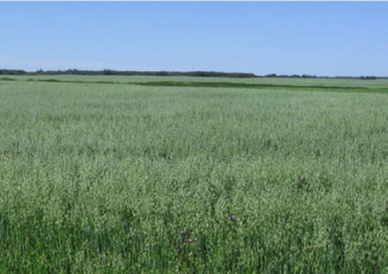
Oat (avena sativa)
High Altitude Composite Maize Fodder
- Availability of forage and grain has potential of increasing milk production, generating wealth from milk and benefiting households.
- Good maize fodder is early maturing maize variety suitable for the cold highlands.
- It is appropriate for silage making because of high biomass.
Fodder Sorghum (Sorghum bicolor) Variety E6518
- An alternative forage for use in dairy cattle feeding suitable for marginal areas.
- It’s a high yielding, drought tolerant fodder crop for silage making.
- Farmers are encouraged to keep their own seed.
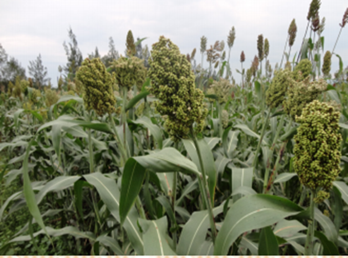
Fodder sorghum
Climate Smart Brachiaria grass
- Brachiaria grass is alternative fodder to Napier grass which is susceptible to head smut and stunting diseases.
- The grass can be used as cut-and-carry, grazed or conserved as hay or silage.
- It is tasty and nutritious with CP of up to 16% and have been widely adapted as livestock feed.
- The grass grows well in areas with more than 700 mm annual mean rainfall, and where temperature exceeds 19oC.
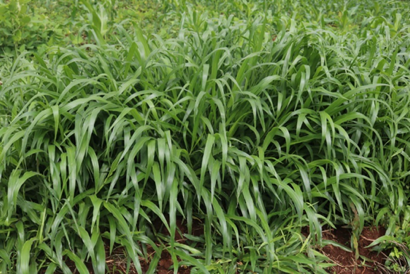
Brachiaria grass
Common Vetch (Vicia sativa) Fodder
Common Vetch –Vicia Sativa Fodder
- Vetch is a climber legume that grows well in association with grasses to produce a mixed ley for grazing and silage making.
- Grows in 2190-2280 m.a.s.l. in lower highlands (LH5) with average annual rainfall of 800-900 mm.
- Temperature range is 4.3-21.1C.
- Best soils are non-acidic sandy or sandy loam.
- Vetch can grow in all types of soils unless they are alkaline or waterlogged.
- Common vetch has high crude protein of above 19% and is highly acceptable as grazed or conserved forage.
- It is persistent and a prolific seeder withstanding competition from grasses.
- About 100 to 150 bales of vetch hay can be harvested in a pure stand of 1 acre.
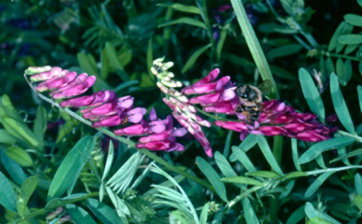
Common Vetch
Desmodium (Desmodium intortum)- Napier grass intercrop.
- Protein rich Desmodium is intercropped with Napier grass to improve the nutritive value of the Napier.
- Feeding Napier grass-Desmodium intercrop increases milk production over Napier grass alone.
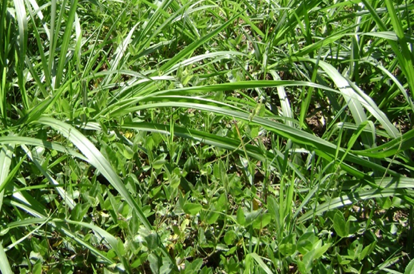
Napier grass desmodium intercrop
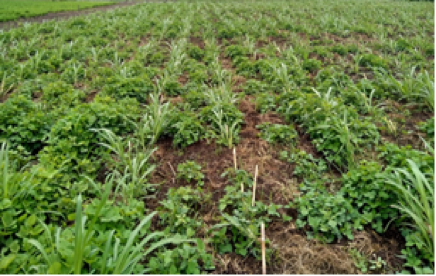
Napier grass desmodium intercrop early stages.
Tree lucerne or tagasaste- (Chamaecytisus prolifera)
- This is a perennial legume shrub rich in protein.
- The leaves are high in protein content and used as fodder.
Sweet lupin (Lupinus albus and Lupinus angustifolius.)
- Lupins are legumes whose grains are rich in crude protein and is an ingredient in animal feeds formulations.
- Use of lupin/maize meal will reduce the cost of dairy supplementation and increase milk production and income.
- Lupin seed meal and maize meal mixed in a ratio of 1:3, will form a concentrate with 17.1% CP. Note: Higher concentrations of the lupin are not recommended as more than 30% of lupin in the diet could cause metabolic upsets.
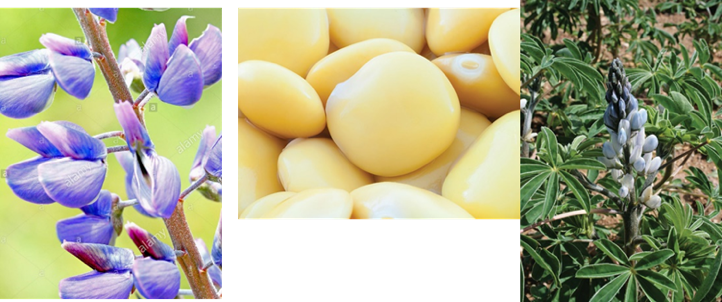
Sweet lupin
Sweet Potato Vines (Ipomoea batatas)
- Fodder sweet potato vines (SPV) have edible tubers which form the roots and its feed reserve.
- They are easily established and rich in crude proteins and very good supplemental fodder for dairy cattle on grasses and maize silage.
- Sweet Potato Vines are perennial and persistent if the tubers are not uprooted. They are prolific and regrow quickly after harvesting the vines.
- The high CP improves the feeding value of grass when fed as a mixture, improving the milk production of dairy cows.
- Vines can be harvested for a long time so long as the tubers are not uprooted.
- Farmers can source planting material from KALRO Muguga, Kakamega and Katumani.
Cassava Based Napier Grass Silage
- Smallholder farmers in Kenya mainly depend on forages to feed livestock.
- Forage is plenty during the rainy season and scarce during the dry season.
- Cassava based napier grass silage is a basal diet conserved towards the end of the wet season for use during the dry season when forage production is low.
- A mixture of wilted chopped Napier grass: wilted cassava leaves: dry or fresh chopped cassava tubers in the ratio of 70:25:5.
- The mixture is fermented under anaerobic conditions for at least six weeks
- The mixture can be ensiled in a pit or small airtight container/bag.
- Silage can be used as a total ration without additional supplementation because its protein content is above 16%
- It should be fed after milking to avoid milk tainting.
- The technology is based on use of unmarketable cassava roots and leaves which are not used for human consumption and would otherwise go to waste.
- Cassava tubers (fresh or dry) can replace molasses in silage making.
- The farmers who used cassava-based Napier grass silage never experienced devastating effects of drought and they sustained milk production.
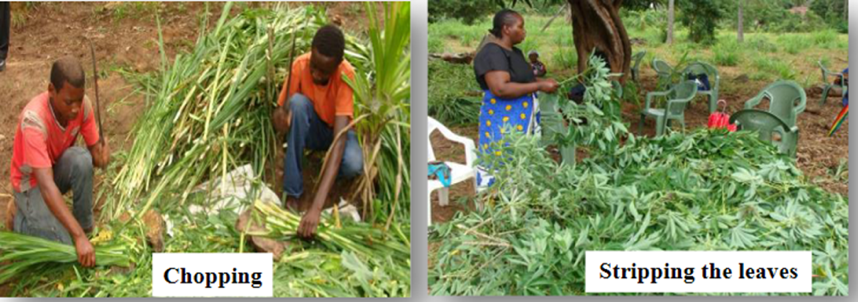
Napier Grass, gliricidia forage and maize bran silage.
- Silage can be used as a total ration without additional supplementation because its protein content is above 16% -
- It should be fed after milking to avoid milk tainting.
- Milk production is therefore low in the dry season due to inadequate and low-quality forages.
- Preservation of surplus forage has the potential for increasing or stabilizing milk production.
- The Napier grass and gliricidia-based silage is an option for providing high quality feed during the dry season.
Feed rations formulation
- This is based on a formula that derives possible dairy ration options for dairy production systems based on feed rations for dairy cows that maximize income over feed costs using locally available feed resources on farms.
- The use of Dairy ration formulations using available feedstuffs on the farms will reduce the cost of production for farmers.
Early Calves’weaning diet as milk replacer
- This is based on feeding male calves born to dairy cows on diets equivalent to milk replacers offered from week 1 post-colostrum.
- The diets are fortified with effective microorganisms, diamond V and diatomite.
- The diets are offered with a basal diet of good quality Napier grass, Rhodes grass and Leucaena.
- It is not cost effective or economical to raise dairy bull calves on milk for farmers who do not wish to raise them to maturity.
- Availability of complete fodder block formulae makes efficient intake and utilization of early calf weaner diets by dairy bull calves.
Crop Residue based Total Mixed Ration (TMR)
- This is a nutritive balanced crop residue based on total mixed ration feed block.
- It contains all major nutrients including proteins, energy and minerals for increased milk production.
- It has molasses to increase energy content and improve taste and has urea to increase protein nitrogen.
- It can be transported and stored easily.
- Establish on farm measures for cattle hygiene to avoid spread of diseases.
- Monitor and manage visitor traffic.
- Clean contaminated vehicles and equipment.
- Know health history of herds where new animals are purchased.
- Know health status of animals brought into herd.
- Transport animals in clean vehicles.
- Isolate new and sick animals.
- Have a control program for other animals that could spread disease (dogs, rodents, insects, external parasites, etc.)
- Manage manure and dispose it frequently.
- Maintain good personal hygiene.
- Adopt a daily routine to inspect all animals on the farm.
- Check for pests like lice and ticks.
- Check out for diseases such as Brucellosis, Foot and mouth disease, Anthrax, East coast fever, Mastitis, Milk Fever, Acidosis, Sore hooves-laminitis, Bloat.
- Early awareness of sickness in animals is important to successful treatment.
- The longer an animal stays sick without treatment the more difficult it is to cure.
Unhealthy Cattle early signs of sickness:
- Stops eating and possibly also drinking.
- Becomes dehydrated.
- The temperature rises or goes down.
- Respiration rate increases.
- The animal becomes dull and lags behind the others.
- The coat becomes rough and loses its shine.
- Diarrhoea or constipation.
- Low milk fat test.
Healthy Cattle signs;
- Breathing is smooth and regular at rest.
- The droppings of the healthy animal will be firm.
- The healthy animal will walk easily and steadily
- The eyes should be bright and alert with no discharge at the corners.
- The nose should be clean with no discharge.
Brucellosis
- It causes early abortions in animals.
Control
- Give mass vaccination of all eligible female calves between ages 6-8 months in the areas where the incidence of the disease is high.
- Get advice from the local veterinary office on animal disease issues.
Foot and Mouth Disease
- Is an infectious viral disease that affects cattle.
- Symptoms include fever, blisters inside the mouth and on the feet that may rupture and cause lameness.
- Excessive salivation (smacking jaw movements in cattle).
- Neo-natal mortality.
Anthrax
A highly infectious and fatal disease of cattle, is caused by a relatively large spore-forming rectangular shaped bacterium called Bacillus anthracis.
Symptoms:
- Sudden death (often within 2 or 3 hours of apparently normal animals) is by far the most common sign.
- Very occasionally some animals may show trembling and high temperature.
- Difficulty breathing, collapse and convulsions before death. This usually occurs over a period of 24 hours.
- After death blood, may not clot, resulting in a small amount of bloody discharge from the nose, mouth and other body openings.
Treatment and Control
- Due to late diagnosis and acute nature of the disease resulting in sudden death, treatment is usually not possible.
- Treatment is useful in cases showing sub-acute form of the disease.
- In most cases, early treatment can cure anthrax.
- The cutaneous (skin) form of anthrax can be treated with common antibiotics.
Black quarter
It is an acute infectious and highly fatal, bacterial disease of cattle.
Symptoms
- Loss of appetite, Depression and dullness.
- Rapid pulse and heart rates.
- Difficult breathing.
- Lameness in affected leg.
Treatment:
- Early treatment can be possible to complete cure of the animal.
- Consult with veterinarian immediately.
East coast fever(ECF)
- An acute disease of cattle usually symptoms are:
- High fever.
- Swelling of the lymph nodes.
- High mortality.
Prevention
- Vaccination
- Tick contro
Improving indigenous cattle for dairy production through targeted selection and cross breeding
- The Sahiwal is a dual-purpose breed adapted to dry areas where it produces about 5-15 L of milk compared to about a litre daily from indigenous cattle.
- Crossbred cows produce about 10 L daily
- The bull calves grow fast and reach maturity early for the slaughter, supplementing the family source of income.
- Farmers should keep proper records of parents (sire and dam) to avoid inbreeding, and track performance records and registration of the offspring in the farms.
Continuous selection and cross breeding to improve indigenous cattle using Sahiwal germplasm.
- The Sahiwal is a dual-purpose breed adapted to dry areas where it produces about 5-15 L of milk compared to about a litre daily from indigenous cattle.
- The technology increases herd productivity.
- Increased productivity of the progeny (crossbreds).
- Crossbred cows produce about 10 L daily
- The bull calves grow fast and reach maturity early for the slaughter, supplementing the family source of income.
Assisted Reproductive Technique (ART)
Use of Assisted Reproductive Technique (ART) and cross breeding to upgrade indigenous cattle using Sahiwal germplasm.
- The animals are injected with hormones to induce ovulation followed by insemination.
- The advantages include: - Planned calving to coincide with feed availability.
- Timely breeding (synchronized ovulation, reduced repeat services) leading to a decrease in calving interval.
- Increased herd productivity and increased productivity of the progeny (crossbreds)
- Successful promotion needs a functional regional Centres for sustainable supply of quality semen.
- Domestic biogas technology come in various designs but can be described generally as either fixed domes, floating drum or tubular models.
- Biogas plants through anaerobic digestion convert organic wastes into biogas (combustible mixture of methane and carbon dioxide) and high-quality fertilizer.
- Gas can be used domestically replacing other biomass fuels (charcoal, firewood).
- Bio-slurry from anaerobic digesters can be used to improve soil fertility, soil structure and crop productivity and reduces need for constant use of chemical fertilizers.
- The lack of access to affordable and efficient energy leads to the dominance of biomass in residential energy supply and attendant forest cover depletion.
- Domestic biogas digesters help in mitigating GHG emissions, reduce biomass fuel consumption and since biogas burns without smoke, it reduces apparent indoor air pollution.
- The technology is carbon neutral, and therefore does not add or remove carbon dioxide from the atmosphere.
- Potentially therefore, it is a significant and profitable way of mitigating global climate change.
Cheese
- Cheese is a milk product obtained from milk solids or proteins known as casein by coagulation of milk, and whey expulsion done in the vat.
- The curd also undergoes cutting, pressing, molding and salting.
- Ready market for value added products exist.
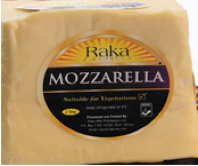
Source:Raka cheese
Cheese production from dairy milk
Yoghurt
How to make Yoghurt
- Ingredients
- 1 litre fresh milk
- 0.6% of milk used or 3-4 table spoonfuls of sugar
- 0.5-2% of milk used or 2 table spoonfuls of yoghurt
- Starter culture
- 5 mls (1 bottle top) of flavour
- 0.5 gram (1 pinch) of food colour.
Procedure
1 Fresh milk testing
• Check for adulteration using a lactometer.
• Check for bacteria or chemical residue using 80% ethanol.
2 Boiling (85-950C)
• Boil for 15-30 minutes to stabilize milk protein.
• Stir to homogenize the milk
• Add sugar
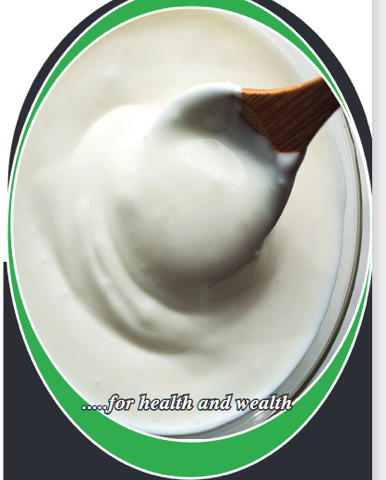
Yoghurt production from dairy milk
3 Cooling (40-450C)
• Cool to lukewarm using water bath.
• Leave at room temperature to lukewarm.
4 Incubation (37-44 0C)
• Add starter culture, food colour and flavor Stir to homogenize the mixture.
Cover and leave overnight or use lukewarm water bath for 4-6hours
5 Stabilization
• Stir the yoghurt until its smooth
• Refrigerate or reheat to stop further re-fermentation
• If reheated, cool to 4.50C or to room temperature in the absence of a refrigerator.
Packaging
• Use clean containers or new plastic milk bags.
• Use metal churns for storage.
The shelf life is about 2-5 days. It can be longer if the yoghurt is refrigerated.
Butter
Butter is a fatty product exclusively from milk whose composition is as follows:- Milk fat 80%, Milk solids nonfat: max 2% , Water: max 16%
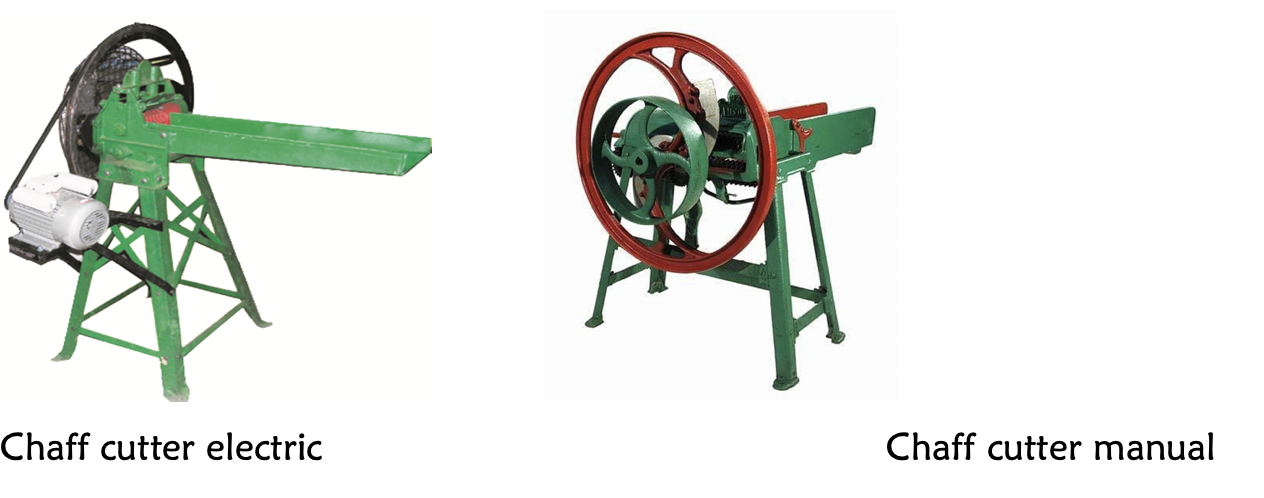
www.nyagah.co.ke/specifications-of-chaff-cutters-and-silage-choppers
Forage choppers (manual & motorized) are generally available in Kenya at competitive prizes.
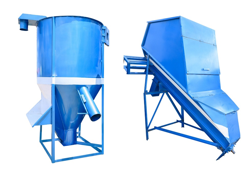
Silage mixer
Source: https://www.google.com/search?q=feed+mixer
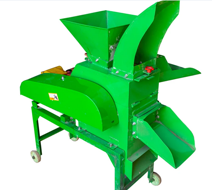
Silage chopper
Basic cost will depend with the number of dairy cattle kept.
Estimated return depends with the management practiced.
Find (get) market for dairy cattle where price and gross margin are better.
KAMIS:amis.co.ke
Contacts
Kenya Agricultural and Livestock Research Organization
P.O. Box 57811-00200, Nairobi, Kenya
Call: 0111010100